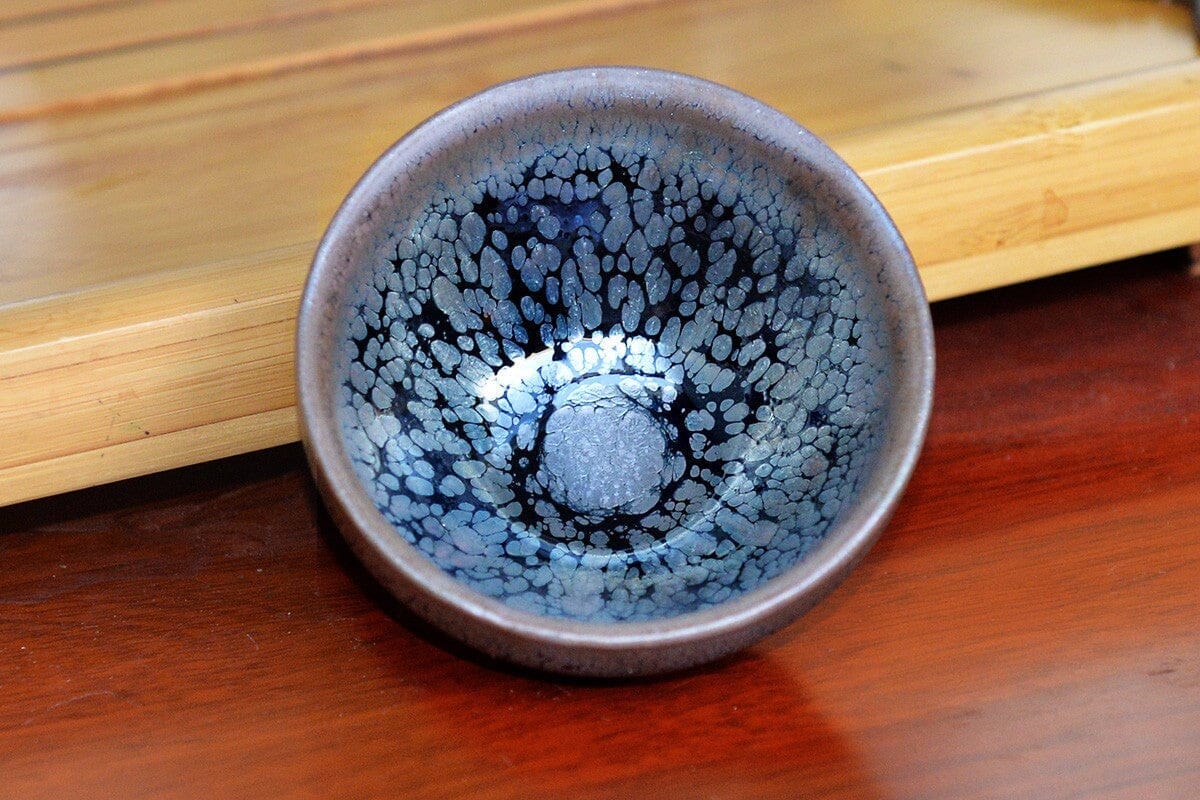There is not a single Tenmoku bowl in the world that is exactly the same, which actually refers to the unique pattern characteristics of each Tenmoku bowl.
Moreover, its bright and heavy color is something that other ceramics do not possess. (Of course, this depends on personal preferences, and there are also tea lovers who do not like the heaviness.)
Its benefits for drinking tea, artistic value, and cultural value are all captivating points.
So today, we will uncover the formation principles of the patterns on commonly seen Tenmoku bowls made with rabbit hair and oil droplets.
- Formation principle of Tenmoku bowls made with rabbit hair.

The iron content in the iron body of Tenmoku bowls can reach up to 9%. During firing, some of the iron dissolves into the glaze layer. Then, the iron is brought to the surface of the glaze. When the temperature reaches 1300℃, the flow of the glaze layer drags the iron into stripes. When it cools down, rows of hematite crystals will precipitate, forming the stripes on the Tenmoku bowls made with rabbit hair.
At the same time, due to the changes during the firing process, the shapes of the rabbit hair patterns on Tenmoku bowls can vary in length, thickness, and fineness.
The colors also have different names such as golden rabbit hair, silver rabbit hair, yellow rabbit hair, gray rabbit hair, blue rabbit hair, and so on.
- Formation principle of Tenmoku bowls made with oil droplets.

The oil droplets are mainly classified into golden oil droplets, blue-silver oil droplets, red oil droplets, rainbow oil droplets, and so on.
The formation principle of oil droplets is that when fired at around 1300℃, under specific physical and chemical conditions, the glaze forms a liquid-phase separation structure.
Under the effects of gravity and surface tension, the iron-rich phase easily floats to the surface layer of the glaze. As the process continues, more and more iron-rich phases float on the glaze surface and can move freely on the liquid surface. They randomly encounter each other, gather in small groups, and finally merge into different-sized clusters.
As the clusters become larger, there are more and more small droplets of liquid phase. After cooling, when the environmental conditions are suitable for the hematite crystal precipitation in the clusters, a Tenmoku bowl with an oil droplet pattern is formed.
The firing temperature of Tenmoku bowls is very high because the pattern on the glaze surface requires it. Once the temperature is too low, the pattern will be sparse or even non-existent. Therefore, during the heyday of Tenmoku kilns, many black-glazed bowls with rabbit hair, oil droplets, and Yao Bian patterns were caused by low firing temperatures or excessive reduction, not because they were deliberately produced.
If the kiln temperature is too high, the patterns will precipitate too many and too densely, covering the base color of the glaze with brown color, while the base color of the glaze remains black.
The sources of various glaze colors are very complex and need to be analyzed specifically based on the evidence. For example, brown glaze may appear when the black glaze layer is thin, the glaze is over-fired, there is insufficient reduction, or the content of oxidized iron in the clay is low.
Therefore, we can see that an excellent Tenmoku bowl is produced based on a large amount of waste material.
The proportion of Tenmoku bowls without major defects is less than one percent.
The proportion of excellent brown rabbit hair Tenmoku bowls is less than one-thousandth.
The proportion of excellent silver rabbit hair Tenmoku bowls is less than one ten-thousandth.
High-quality Tenmoku bowls are extremely rare, and this can also be seen from a large number of physical objects and pictures.









Share:
Understand Tenmoku glaze color mystery in 5 minutes: a concise guide
5 characteristics help understand the beauty of black porcelain's "mysterious darkness"